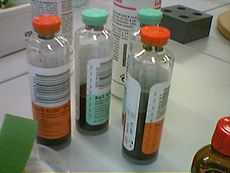Blood culture
| Blood culture | |
|---|---|
| Intervention | |
 Blood culture | |
| ICD-9: | 90.52 |
| MedlinePlus | 003744 |
Blood culture is a microbiological culture of blood. It is employed to detect infections that are spreading through the bloodstream (such as bacteremia, septicemia amongst others). This is possible because the bloodstream is usually a sterile environment.
History
Blood cultures were pioneered in the early 20th century.
Purposes
When a patient shows signs or symptoms of a systemic infection, results from a blood culture can verify that an infection is present, and they can identify the type (or types) of microorganism that is responsible for the infection. For example, blood tests can identify the causative organisms in severe pneumonia, puerperal fever, pelvic inflammatory disease, neonatal epiglottitis, sepsis, and fever of unknown origin (FUO). However, negative growths do not exclude infection.
Risks
The usual risks of venipuncture and the occurrence of false positive results (3+%) leading to inappropriate treatment.[1]
Method
A minimum of 10 ml of blood is taken through venipuncture and injected into two or more "blood bottles" with specific media for aerobic and anaerobic organisms. A common medium used for anaerobes is thioglycollate broth.
The blood is collected using aseptic technique. This requires that both the tops of the culture bottles and the venipuncture site of the patient are cleaned prior to collection by swabbing with 70% isopropyl alcohol (povidone and left to dry before venipuncture).[2]
To maximise the diagnostic yield of blood cultures, multiple sets of cultures (each set consisting of aerobic and anaerobic vials filled with 3–10 mL) may be ordered by medical staff. A common protocol used in US hospitals includes the following:
- Set 1 = left antecubital fossa at 0 minutes
- Set 2 = right antecubital fossa at 30 minutes
- Set 3 = left or right antecubital fossa at 90 minutes
Ordering multiple sets of cultures increases the probability of discovering a pathogenic organism in the blood and reduces the probability of having a positive culture due to skin contaminants.
After inoculating the culture vials, advisably with new needles and not the ones used for venipuncture, the vials are sent to the clinical pathology microbiology department. Here the bottles are entered into a blood culture machine, which incubate the specimens at body temperature. The blood culture instrument reports positive blood cultures (cultures with bacteria present, thus indicating the patient is "bacteremic"). Most cultures are monitored for five days, after which negative vials are removed.
If a vial is positive, a microbiologist will perform a Gram stain on the blood for a rapid, general identification of the bacteria, which the microbiologist will report to the attending physician of the bacteremic patient. The blood is also subcultured or "subbed" onto agar plates to isolate the pathogenic organism for culture and susceptibility testing, which takes up to three days. This culture and sensitivity (C&S) process identifies the species of bacteria. Antibiotic sensitivities are then assessed on the bacterial isolate to inform clinicians with respect to appropriate antibiotics for treatment.
[3] Some guidelines for infective endocarditis recommend taking up to six sets of blood for culture (around 60 ml).
See also
References
- ↑ Madeo M, Davies D, Owen L, Wadsworth P, Johnson G, Martin C (2003). "Reduction in the contamination rate of blood cultures collected by medical staff in the accident and emergency department". Clinical effectiveness in Nursing 7: 30–32. doi:10.1016/s1361-9004(03)00041-4.
- ↑ Kiyoyama T, Tokuda Y, Shiiki S et al. (2009). "Isopropyl alcohol compared with isopropyl alcohol plus povidone-iodine as skin preparation for prevention of blood culture contamination". J Clin Microbiol 47 (1): 54–58. doi:10.1128/JCM.01425-08. PMC 2620854. PMID 18971366.
- ↑ Bouza E, Sousa D, Rodríguez-Créixems M et al. (2007). "Is blood volume cultured still important for the diagnosis of bloodstream infections?". J Clin Microbiol 45 (9): 2765–9. doi:10.1128/JCM.00140-07. PMC 2045273. PMID 17567782.
- Department of Health (2007) Saving lives: Reducing infection, delivering clean and safe care London: DoH
- Donnino MW, Goyal N, Terlecki TM et al. (September 2007). "Inadequate blood volume collected for culture: a survey of health care professionals". Mayo Clin. Proc. 82 (9): 1069–72. doi:10.4065/82.9.1069. PMID 17803874.
- Madeo M, Barlow G (July 2008). "Reducing blood-culture contamination rates by the use of a 2% chlorhexidine solution applicator in acute admission units". J. Hosp. Infect. 69 (3): 307–9. doi:10.1016/j.jhin.2008.03.009. PMID 18511153.
- Madeo M, Jackson T, Williams C (November 2005). "Simple measures to reduce the rate of contamination of blood cultures in Accident and Emergency". Emerg Med J 22 (11): 810–1. doi:10.1136/emj.2005.003079. PMC 1726605. PMID 16244343.
- Mimoz O, Karim A, Mercat A et al. (December 1999). "Chlorhexidine compared with povidone-iodine as skin preparation before blood culture. A randomized, controlled trial". Ann. Intern. Med. 131 (11): 834–7. doi:10.7326/0003-4819-131-11-199912070-00006. PMID 10610628.
- Shore A, Sandoe J (2008). "Blood Cultures". Student BMJ 16: 324–5.
- Pratt RJ, Pellowe CM, Wilson JA et al. (February 2007). "epic2: National evidence-based guidelines for preventing healthcare-associated infections in NHS hospitals in England". J. Hosp. Infect. 65 (Suppl 1): S1–64. doi:10.1016/S0195-6701(07)60002-4. PMID 17307562.
- Lee A, Mirrett S, Reller LB, Weinstein MP (November 2007). "Detection of bloodstream infections in adults: how many blood cultures are needed?". J. Clin. Microbiol. 45 (11): 3546–8. doi:10.1128/JCM.01555-07. PMC 2168497. PMID 17881544.